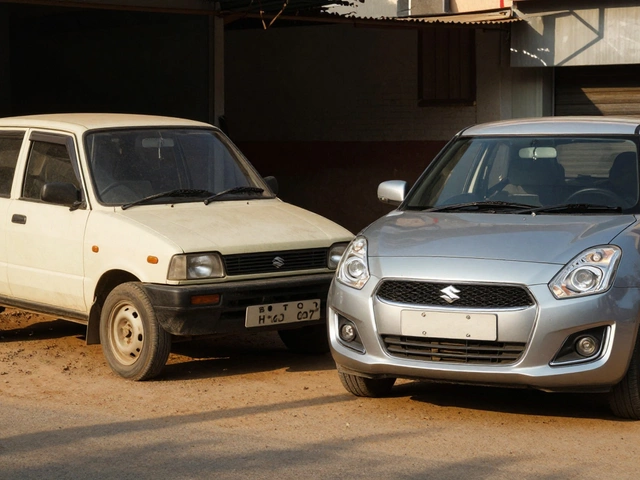How Much Money Do You Really Need to Start a Small Scale Business in 2025?

Ever sat with friends at tea stalls, tossing around 'million dollar' ideas, only to hear someone say, “All this needs is money!”? The words hang in the air, like an unsolved riddle. But what’s the real number you need in your bank account to kick off a small scale business in 2025? I kept hitting that wall myself, and so did Neha while helping her cousin start a small food processing unit last year. Spoiler: it's not always as simple as website lists make it out to be.
Understanding Small Scale Business Costs: Beyond the Obvious
People love throwing around round figures — “5 lakhs is enough!” or, “You’ll need at least 10 lakhs these days.” Truth is, the money you need depends on what you want to build, where you’re based, and how you plan to operate. According to a 2024 Deloitte report, the average cost to launch a micro or small scale business in India was about ₹6.75 lakhs. But here’s a twist: nearly 30% of that budget often gets missed, hidden under "miscellaneous" or "unexpected costs." Intimidating, right?
Let’s break down the main costs you need to think of, regardless of your industry:
- Registration and Licenses — Even home bakeries need FSSAI permits and local registrations, which can set you back a few thousand rupees right away.
- Rental and Security Deposits — If you don’t own a shop or workspace, be ready to cough up 2–6 months' rent as a security deposit. In cities like Pune or Bangalore, this can cross ₹1 lakh.
- Equipment and Machinery — Buying second-hand machines? New gear for a small manufacturing setup? Plan for at least ₹1–4 lakhs, depending on what you make or sell. A cloud kitchen can start lean with ₹2 lakhs, but a miniature garment unit will set you back closer to ₹5–7 lakhs.
- Raw Materials and Stock — Even to open with half-empty shelves, you need stock. Even a small snack vendor sinks at least ₹10,000 into initial supplies.
- Staff Salaries — At the start, maybe it’s just you and your sibling, but most manage with at least one helping hand. Minimum wage varies, but plan at least ₹10,000–₹15,000 per month, per person.
- Marketing — Your aunt may have a ‘miracle WhatsApp group’ for word of mouth, but social media boosts and banners will set you back a minimum of ₹5,000–₹10,000 to get started.
- Utilities and Contingencies — You’ll need power, water, and a buffer for when things break, prices spike, or your cousin runs the wrong ad. Set aside at least 15% of your launch capital for these curveballs.
No two businesses budget exactly the same way, but every successful one includes a contingency fund. The average Indian startup loses track of 11% of its original budget within three months, according to a 2023 CII survey. Not preparing for this? It’s probably more expensive than buying fancy interiors or ad time.
Here’s a quick sample of typical small business startup costs in India for 2025:
| Expense Type | Estimated Cost (₹) |
|---|---|
| Registration & Licenses | 10,000–50,000 |
| Rent/Security Deposit | 50,000–2,00,000 |
| Equipment & Machinery | 1,00,000–4,00,000 |
| Raw Materials/Inventory | 15,000–1,00,000 |
| Staff Salaries | 20,000–60,000 |
| Marketing & Branding | 5,000–20,000 |
| Utilities & Miscellaneous | 15,000–50,000 |
This makes it easier to see where your money actually goes, and why it adds up so quickly if you miss one thing.
Another surprise many face: government fees and taxes. Small businesses with turnovers under ₹40 lakhs per year don’t need to register for GST, but if you plan to scale or work with corporates, you’ll want GST registration and even digital signature certificates (DSC), each costing a few extra thousand.
The takeaway? Don’t just budget for the “big things.” Leave headroom for the little things that eat away at your pile when you least expect them. As entrepreneur Ankur Warikoo put it,
"You’ll run out of enthusiasm before you run out of ideas, but you’ll run out of money before both, if you don’t get your budgets straight."

Hidden Costs and Common Mistakes When Budgeting for Startups
Thousands of people start businesses with dreams in one hand and an excel sheet in the other. Yet, so many miss the sneaky, hidden costs that sneak up after launch. One of the most painful lessons: forgetting how much time and money government paperwork eats up. What starts as a quick online registration often leads to endless “urgent” calls from consultants and notaries. Some end up spending twice what they’d budgeted for so-called ‘minor fees.’ In fact, a 2024 PHDCCI report showed first-time entrepreneurs often overspend by 22% due to unplanned regulatory and compliance costs.
Let’s talk about rent. Commercial landlords want more than just your monthly payment—they’ll usually ask for a security deposit of up to six months’ rent, especially if you’re new and young. Skip this, and you might find yourself running from pillar to post searching for extra cash before even setting up your board.
The other trap is overestimating sales in the first 6 months. Optimism is great, but almost every survey shows it takes longer to hit break-even. I learned the hard way with a gifting business in Delhi: you can exhaust 70% of your launch fund just staying open until sales catch up.
One more costly mistake is spending on fancy gear too soon—shiny machines, pricey POS setups, or high-end shop decor that you don’t really need (yet). Many smart founders now buy good-quality second-hand equipment first, then scale up as profits grow. Even Google’s first servers sat inside a DIY plywood case. Scrappiness beats flashiness when margins are thin!
Pay special attention to working capital: the dry powder that lets you restock, pay wages, and handle sudden cash hiccups. Banks love “cost of project” charts and “projected income” tables, but what keeps businesses afloat is float—the little pile of money that stops a cash crunch from closing your doors.
Health insurance and ESI/EPF for staff aren’t optional anymore; the 2023 labor law updates mean you’ll pay fines for ignoring employee benefits, even for small businesses. Many owners still think only big companies need to bother, then get stuck with ugly surprise penalties.
Unexpected things break or change. Think monsoon leaks, water tank repair, a generator you didn’t know you’d need, or a sudden local supply chain hiccup. That’s why many seasoned owners, like my neighbor running a printing press, swear by keeping “rainy month” funds in a separate account.
Bank fees, UPI setup costs, yearly filing charges—all small, but when combined, they eat up more than you’d expect. As per RBI’s 2024 report, small business owners pay around ₹8,400 annually just in banking and maintenance fees.
- Never skip the cost of a basic website or online presence. A simple, mobile-friendly site can cost as little as ₹8,000, and saves you from getting lost in the crowd. Social media profiles are free, but real reach often means spending on ads and basic branding.
- Don’t forget legal costs. Have an experienced CA or company secretary review your paperwork. Saving three thousand bucks today can mean losing lakhs in a poorly-worded partnership agreement tomorrow.
- If you’re relying on family for free labor (like Neha’s cousin did), budget for some kind of honorarium or bonus. It keeps tempers calm and helps avoid family drama late at night when coffee and patience run low.
One last thing: pandemics, power cuts, sudden strikes, or new government rules—these can pop up without warning. The 2020–2021 lockdown taught everyone this lesson in HD, but short memories quickly forget it. Planning a proper buffer isn’t being pessimistic—it’s street-smart survivability.

How to Plan, Save, and Fund Your Small Scale Business
Starting strong means plotting your budget, then padding it. The golden rule: whatever you think you need, add at least 20% extra for surprises. Smart founders take a week to talk to actual small business owners in their field, not just consultants—they get the real “backstage numbers” that matter.
Here’s how most new business owners in India pull together money in 2025:
- Self-Funding: Savings, small family loans, or selling unused gadgets add up. Most small businesses start this way, with 78% of Indian MSMEs launched using just family, savings, and personal gold loans.
- Government Schemes: Programs like Mudra Yojana and Stand-Up India still help thousands each year. Banks usually process loans up to ₹10 lakhs with minimal collateral. But be ready for piles of paperwork.
- Private Loans: Some go to NBFCs or private lenders, but watch out for high interest. Use them only if you can flip fast and pay back.
- Angel Investors: Less common for micro-ventures, but if your idea is tech-based or highly scalable, hunt for local investor meets or pitch events.
Banks love a good, clean business plan. Here’s what you need to put together for loans or investor pitches:
- Clear business model — What are you selling and to whom?
- Estimated costs, line-by-line — Don’t hide numbers under “misc”.
- Break-even projection — How fast will you recover your investment, even conservatively?
- Cash flow plan — How much working capital will keep things running?
Talking to people who already run similar ventures is like looking at cheat sheets before an exam. They’ll tell you about those tiny expenses you never considered, like the guy charging you just to move your new machine into your first rented shop. I learned this from a friend who runs a T-shirt printing shop; “The first mistake is underestimating moving-in costs. Even the movers want their chai money upfront.”
Another smart tip: Don’t try to do everything at once. I see so many beginners spending heavily on branding, fancy interiors, or shiny technology that their customers don’t even care about yet. Start with the core—what gets you your first ten paying customers, then build slowly as the sales come in.
If you’re looking for grants, check sites like SIDBI’s online portal or state government MSME programs. While these are real, competition is stiff and results take months, not days. Meanwhile, zero in on frugal hacks: reusing old furniture, negotiating better inventory credit, bartering with friends for services, or sharing workshop space with someone trustworthy.
One interesting stat: According to a 2024 IndiaStartUp survey, businesses that piloted their product or service with small, community launches, rather than going big right away, survived two years at double the rate of those with splashy launches.
Want a basic launch checklist? Here goes:
- Pick your business type — shop, service, processing, home-based, etc.
- Get permits and registrations early — delays can derail your timeline.
- Create a clear budget, with costs broken down into setup, operating, and emergency buckets.
- Talk to actual owners in your field.
- Find reliable suppliers and backup sources for key raw materials.
- Start lean, focus on what sells, and pad your savings for rainy days.
The answer to “How much do I need to start a small scale business?” isn’t a universal number. It’s a calculation only you can make once you know what, where, and how you want to run your dream. Shoot for a base budget but shield yourself with extra savings, just in case. Business is less art and more survival—and survival loves a well-padded wallet.





